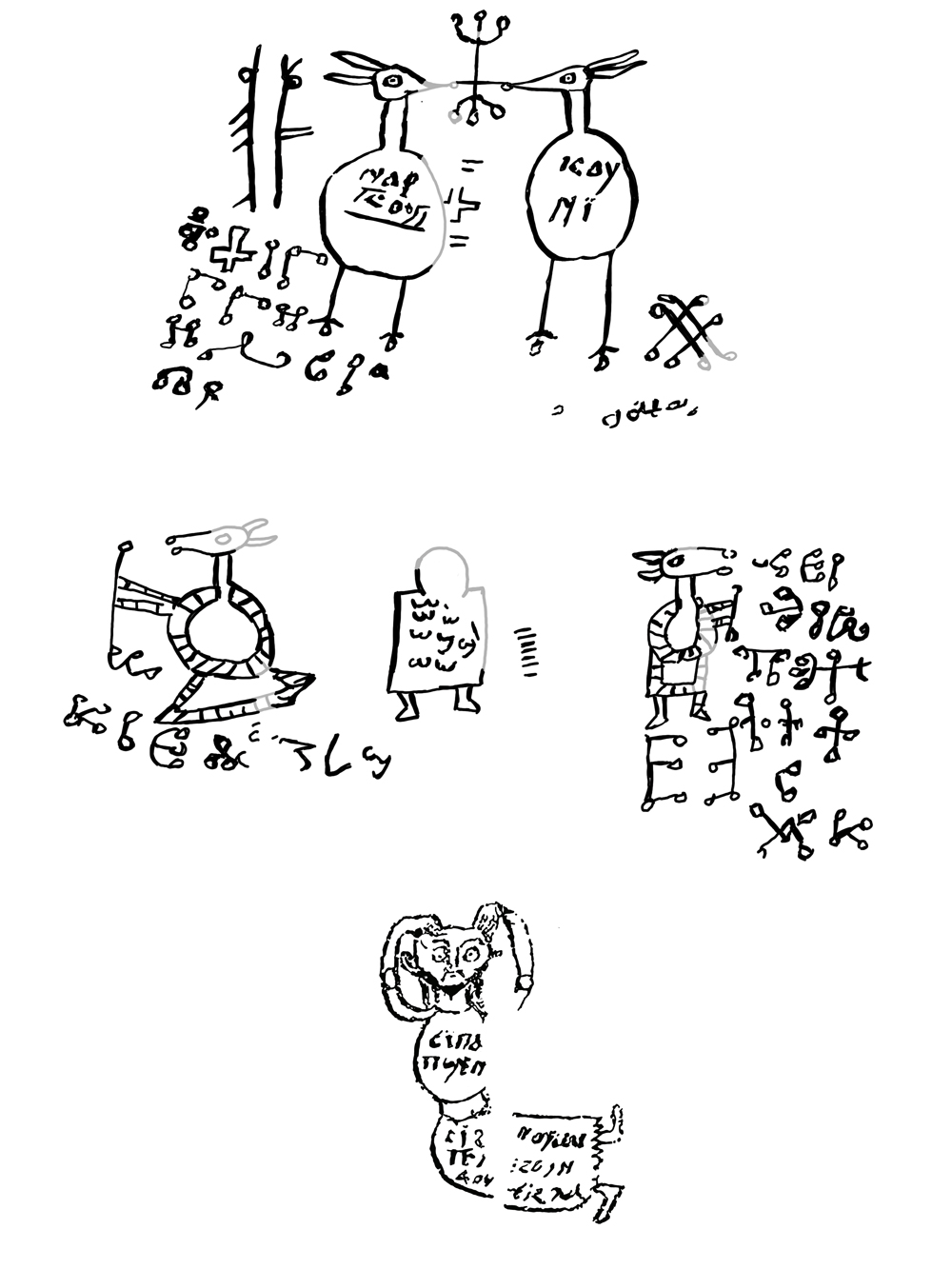| Manuscript: | M367 |
| Sigla: | Louvre E 14.250 |
Text no.  Position of the text within the manuscript.
Position of the text within the manuscript. | 1 |
| Coptic Scriptorium: | |
| Date: | 901 – 1000 |
| Text position: | Ro ll. 1-36 -Vo ll. 1-13 |
| Type of text: | Curse (magical applied, separation) |
| Original title: | |
| Original title (translated): | |
| Conventional title: | Applied curse to separate Sipa son of Siheu from Ouerteihla the daughter of Cahaure and Cahaure herself. |
| Language: | Egyptian (Coptic) |
| Dialect: | Sahidic with Lycopolitan or Akhmimic features |
| Script: | Coptic |
| Image: | https://collections.louvre.fr/ark:/53355/cl010048235 |
| Text: | Translation: |
| Recto [tableau 1 Inside body of right figure: Kharaktēres left of figures: Further complex and/or illegible kharaktēres below and to the right] [tableau 2 Verso Inside body of figure: 6. ϫⲉⲕⲁⲥ ⲉ[ⲧⲉ]ⲧⲛⲛⲁϯ ⲛⲟⲩⲙⲁⲥ ⲙⲛ ⲟⲩⲡⲟⲣϫ ⲙⲛ ⲟⲩⲁϣⲁⲗ ⲙⲛ ⲟⲩ- |
Recto [tableau 1 Kharaktēres left of figures: [13] I am the [sheet, the one who] separates a friend from friends; [14] I [am the one who separates the earth (?) from (?) the] sea; I am the one who separates [15] Sipa, [the son of Sihēu, from] Ouarteihla, the daughter of Cauhare, [16] so that [as soon as] your images and your [17] amulets [and] your names [are placed at the] door of this tomb of these pagans, these dead ones, [18] Sipa, the son of Sihēu, will not visit [19] the door of the house of Ouarteihla, [the] daughter of Cauhare, ever! [20] He will not be able to […] out! You will give hatred [21] and separation [and strife] and a cry [to] Sipa, the son of [22] Sihēu, towards Ouarteihla, the daughter of Cauhare! [23] [None of them will be able to look at the face of] another of them, forever, [24] yea, yea! Give [hatred and separation to] Sipa, the son of Sihēu, towards [25] Ouarteihla, [the daughter of Cauhare and] Cauhare! [tableau 2 [26] I am the sheet, the one who separates a brother from his brother; [27] I am the one who separates a bride from her husband; I am the [28] sheet, the one who separated Pharaoh from his people [29] because of the multitude of its powers; I am the one who incited Judas against [30] Jesus so that he was crucified upon the wood of the Cross; I am the one who [31] flew up to heaven and cried out, “Eloi Ei Ēlemas, I too am [32] a god!” I, indeed, I entreat and I invoke you today, [33] Apolle (?), so that as soon as you are placed under the head of … [34] bring hatred and separation to Sipa, the son of Sihēu; he will not visit [35] the [door (?)] of Ouarteihla, [36] the daughter of Cauhare! Verso [1] Sipa, [2] the son of [3] Sihēu, [give] hatred [4] to [him] towards [5] Ouarteihla! [6] so that you shall give hatred and separation and a cry and [7] strife to Sipa, the son of Sihēu, towards Ouarteihla, [8] the daughter of Cauhare! None of them will be able to look at the face of another [9] of them, ever, through the power of these names which are: Thkou, [10] Lorolle, Morau, Pithos, Sakhaous, Sth … ēm, Sennes, [11] Nokoknia! Give hatred and separation to Sipa, the son of [12] Sihēu, towards Ouarteiouhla and her mother, Cauhare, [13] yea, yea, quickly, quickly! |
| Tracing by: | KD (2017, 10/2021) |
| Apparatus: | Recto Verso |
| Notes: | Recto |
| Bibliography: | Crum MSS 5.5 (Griffith Institute Archive) |
| Editor: | EL’s edition, with apparatus and notes, based on new transcription from photographs of the original (15/6/2014); EL (5/9/2019); team (8/9/2021) |

